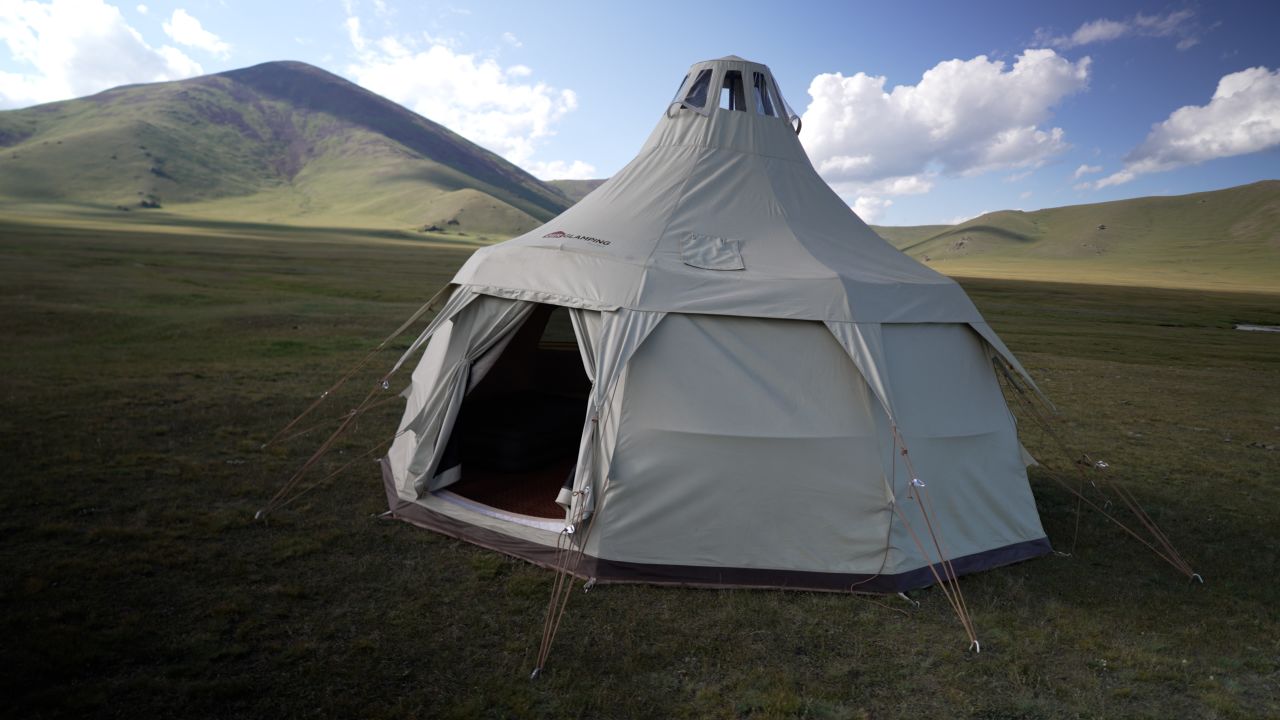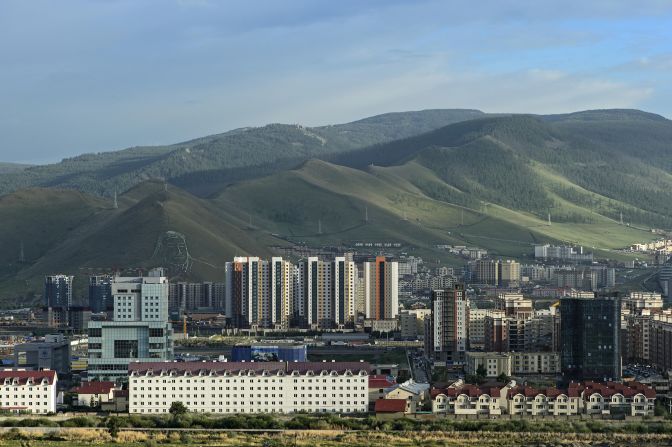Editor’s Note: This CNN Travel series may have adjacent ads by the country it highlights. CNN retains full editorial control over subject matter, reporting and frequency of the articles and videos, in compliance with our policy.
Ulaanbaatar, Mongolia
CNN
—
Many American schoolchildren grow up learning that Yellowstone was the world’s first national park. But across the globe in Mongolia, just south of the capital, Ulaanbaatar, a mountain holds a claim to the crown.
Like many things in Mongolia, that mountain has a connection to Chinggis Khan (also known as Genghis Khan), who founded the Mongol empire in the 1200s and whose name and likeness are ubiquitous in present-day Mongolia.
Toghrulkhan (known as Toghrul or Ong Khan), a close friend and ally of Khan’s father, protected and venerated Bogd Khan Uul. According to the historical work “Secret Lives of the Mongols,” the oldest existing book in Mongolia, Toghrul barred anyone from hunting and logging, among other activities, as early as the 13th century.
Today, entering Bogd Khan Uul, which was recognized as a UNESCO biosphere reserve in 1996, banishes the memory of the crowds and pollution of the capital. The Terelj River carves a path through dense patches of pine, birch and aspen trees. White butterflies swirl past in groups.
As a result of the park’s long-standing respected status, many native plants and animals have flourished, protected from hunting and farming. They include the rare musk deer — notable for having tusklike teeth — and the Arctic hare. Visitors should also be on the lookout for eagles, vultures, marmots and wild boars.
Bogd Khan Uul National Park
The mountain of Bogd Khan Uul “is sacred and symbolic for all the Mongols,” says Saruul-Erdene Myagmar, an Ulaanbaatar native who is a Mongolia specialist at the Library of Congress in Washington, DC.
Bogd means “saint” in Mongolian, and “uul” is mountain, while Khan is a ceremonial title given to rulers. One translation of Bogd Khan Uul is “the Khan’s saint’s mountain.”
And what about the claim that Bogd Khan Uul is older than Yellowstone?
In 1778, Mongolian aristocrats wrote to the emperor of the Qing (Manchu) dynasty, which ruled the area at the time, asking for Bogd Khan Uul to be designated an official protected area. He said yes.
Meanwhile, Yellowstone, which stretches across parts of Wyoming, Idaho and Montana, was established in 1872. By comparison, Australia got its first national park in 1879, Canada in 1885, France in 1963 and Egypt in 1983.
In the Caribbean, there’s another contender.
The Tobago Main Ridge Forest Reserve, established in 1776, also has a claim to being the world’s oldest protected area.
But many Mongolians ignore the 1778 date and mark the beginning of Bogd Khan Uul’s “protected status” as during the 13th century, which would put the park ahead of its competitors by several centuries.
Unlike Yellowstone and other famous parks, Bogd Khan Uul remains relatively unknown in the rest of the world. That has a lot to do with Mongolia’s location — this cold, landlocked country wedged between China and Russia has not seen many international visitors. Much of the information about the park and its history is only available in Mongolian.
However, that is changing. Mongolia is investing heavily in tourism and hopes the industry can grow to contribute 10% to its economy by 2030. About 808,000 foreign tourists visited Mongolia in 2024, the highest number in history.
For Mongolians like Myagmar, the mountain’s significance is not just about whether it really is the world’s oldest national park or not.
“Before Buddhism even, there’s the shamanism. Very ancient belief is that all the mountains and rivers have their own owner. It’s almost like a ghost,” he says. “Bogd Uul’s owner is this white old man. If we offend this owner, then all sorts of bad things will happen.”
The park’s spiritual legacy remains. Today, Bogd Khan Uul is dotted with ovoos, which are sacred cairns made of rocks, pieces of wood and colorful scraps of fabric. At the park, it’s considered bad manners, if not downright bad luck, to leave behind trash, use the bathroom outside of designated areas or interfere with an ovoo.
Hikes and ger camps
Many travelers staying in the city center combine a visit to the national park with a stop at Zaisan Hill, home to a monument of the same name. This dramatic Brutalist memorial has colorful murals on the inside and is dedicated to Soviet and Mongolian soldiers killed during World War II.
Perched on top of a hill, it’s a good way to get a sense of one’s bearings and a view of the city. However, this largely depends on the sky conditions that day — the air in “UB,” as locals call it, can be very hazy.
From the Zaisan Monument, it’s a short walk to the northern entrance of Bogd Khan Uul. There are trails that range from easy to difficult, all well marked.
<div data-uri="cms.cnn.com/_components/video-resource/instances/cmcwzodbj001x3b6nljf00rqv@published" data-component-name="video-resource" data-editable="settings" class="video-resource" data-fixed-ratio="16×9" data-canonical-url-path="/2025/02/03/travel/video/mongolia-ger-glamping-spc-hnk" data-parent-uri="cms.cnn.com/_components/video-resource/instances/cm6oq095c00003b6m4kngdqoz@published" data-video-id="me1d0bc3f66c410ab30a4bdb19fbea2813608a1e2b" data-media-id="me1d0bc3f66c410ab30a4bdb19fbea2813608a1e2b" data-live="" data-analytics-aggregate-events="true" data-custom-experience="" data-asset-type="hlsTs" data-auth-type="none" data-content-type="mediasource-clip" data-medium-env="" data-autostart="disabled" data-show-ads="true" data-source="CNN" data-featured-video="true" data-headline="This Mongolian startup can help you glamp like a nomad" data-has-video-player="true" data-description="<p><em>Family business</em><strong><em> </em></strong><em>Ger Glamping designs tents based on traditional Mongolian yurts or “gers”, made to withstand the country’s harsh weather conditions.</em></p>" data-duration="03:47" data-source-html='<span class="video-resource__source"> – Source:
<a target="_self" href="https://www.cnn.com/" class="video-resource__source-url">CNN</a>
</span>' data-fave-thumbnails='{"big": { "uri": "https://media.cnn.com/api/v1/images/stellar/prod/mongolia-stills34.jpg?c=16×9&q=h_540,w_960,c_fill" }, "small": { "uri": "https://media.cnn.com/api/v1/images/stellar/prod/mongolia-stills34.jpg?c=16×9&q=h_540,w_960,c_fill" } }' data-vr-video="false" data-show-html="” data-byline-html='<div
data-uri=”cms.cnn.com/_components/byline/instances/cm6oq0cwz00033b6mhx42hud3@published”
data-component-name=”byline”
class=”byline vossi-byline”
data-editable=”settings”
>
<div class=”byline__images”>
</div>
<div class=”byline__names vossi-byline__names”>
By <span class=”byline__name”>Hazel Pfeifer</span>, CNN
</div>
</div>’ data-timestamp-html='<div
class=”timestamp vossi-timestamp”
data-uri=”cms.cnn.com/_components/timestamp/instances/cm6oq0cwe00023b6m7d86din2@published”
data-editable=”settings”
>
Published
9:16 PM EDT, Thu July 10, 2025
</div>’ data-check-event-based-preview=”” data-is-vertical-video-embed=”” data-network-id=”” data-publish-date=”2025-02-03T07:34:49.289Z” data-video-section=”travel” data-canonical-url=”https://www.cnn.com/2025/02/03/travel/video/mongolia-ger-glamping-spc-hnk” data-branding-key=”” data-video-slug=”mongolia-ger-glamping-spc-hnk” data-first-publish-slug=”mongolia-ger-glamping-spc-hnk” data-video-tags=”” data-breakpoints='{“video-resource–media-extra-large”: 660}’ data-display-video-cover=”true” data-details=””>

Travelers who make it to the top of the mountain should not miss the ruins of the Manzushir Monastery. Once a Buddhist stronghold and home to many monks, Manzushir was destroyed in 1937 by local communists who had joined forces with the Soviet occupiers of the country. Still, the ruins and remaining religious objects are well looked after by residents, especially as the current government is encouraging Mongolian pride and identity.
Most foreign tourists opt for day hikes in Bogd Khan Uul, but those who want to stay the night have a few options with local companies that operate camps of gers, the traditional round Mongolian tents. These camps are rustic and have only basic amenities, but they provide a rare chance to experience the exceptional peace and quiet while stargazing and — for much of the year — watching the snow fall.
Getting in and around
Although Bogd Khan Uul is only about 10 miles south of central Ulaanbaatar, the city’s notoriously congested traffic means it can take up to an hour to get to the park at peak times of day.
Your best bet is to go there on a weekday just after morning rush hour, giving you plenty of daylight for exploring.
Public transit is limited in Ulaanbaatar — there is no subway system, so people either use buses or their own cars to get around. Taxis are generally not labeled — most people simply stand on the side of the road with their hand out and wait for one to pull up. There is an available taxi app, called UBCab app, that offers English functionality, but you’ll need cash to pay if you don’t have a Mongolian bank account.
The country’s air hub, Chinggis Khaan International Airport (UBN), is about an hour and a half from the park.
The airport is mostly limited to short-haul flights from Asian cities like Seoul, Hong Kong and Beijing. United Airlines operates seasonal flights to Mongolia from the US, but they require a stopover in Tokyo.
Beyond Bogd Khan Uul, Mongolia is home to some of the world’s most diverse landscapes and has a total of 29 national parks.
Among them are parts of the Gobi Desert; the UNESCO-listed Orkhon Valley, about five hours’ drive from Ulaanbaatar; the Altai Mountains in far western Mongolia (home to the country’s tallest peak, Tavan Bogd); and the beautiful Lake Khuvsgul, an ancient body of water near the Russian border.





